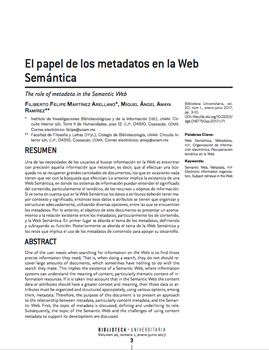The role of metadata in the Semantic Web
DOI:
https://doi.org/10.22201/dgb.0187750xp.2017.1.171Keywords:
Semantic Web, Metadata, rdf Electronic information organization, Subject retrieval in the WebAbstract
One of the user needs when searching for information on the Web is to find those precise information they need; That is, when doing a search, they do not should re- cover large amounts of documents, which sometimes have nothing to do with the search they make. This implies the existence of a Semantic Web, where information systems can understand the meaning of content, particularly thematic content of in- formation resources. If it is taken into account that in the Semantic Web the content data or attributes should have a greater context and meaning, then those data or at- tributes must be organized and structured appropiately, using various options, among them, metadata. Therefore, the purpose of this document is to present an approach to the relationship between metadata, particularly content metadata, and the Semantic Web. First, the topic of metadata is discussed, defining and underlining its role. Subsequently, the topic of the Semantic Web and the challenges of using content metadata to support its development are discussed.Downloads
References
Berners-Lee, Tim. Metadata Architecture. [en línea]. 1997. <http://www.w3.org/DesignIssues/ Metadata.html> [Consulta 15 enero 2015].
Berners-Lee, Tim. Semantic web road map. [en línea]. 1998. <https://www.w3.org/DesignIssues/ Semantic.html> [Consulta 15 enero 2015].
Berners-Lee, Tim.; hendler, J & lassila, O. The Semantic Web. [en línea]. 2001. [Consulta 15 enero 2015].
Caplan, Priscilla. You call it corn, we call it syntax-independent metadata for document like objects. the public access computer systems review, 4(69), 19-23. [en línea]. 1995. <https://journals.tdl.org/pacsr/index.php/pacsr/article/viewFile/5992/5621> [Consulta 15 enero 2015].
Codina, Lluís & rovira, Cristòfol. La web semántica. [en línea]. 2006. <http://eprints.rclis. org/8899/1/web_semantica.pdf> [Consulta 15 enero 2015].
Doan, Bich-Lien., beingbeder, Michel., girardot, Jean-Jacques. & Jaillon, Philippe. Using metadata to improve organization and information retrieval on the www. [en línea]. 1998. <http://files.eric.ed.gov/fulltext/ED427698.pdf> [Consulta 15 enero 2015].
Dublin core metadata initiative. Dublin Core Metadata Element Set, Version 1.1. [en línea]. 2012. <http://www.dublincore.org/documents/dces/> [Consulta 15 enero 2015].
Gruber, Tom. What is an Ontology? [en línea]. 1993. <http://ejournal.narotama.ac.id/files/ Ontology.pdf> [Consulta 15 enero 2015].
Lamarca lapuente, María Jesús. Hipertexto: El nuevo concepto de documento en la cultura de la imagen. [en línea]. 2013. <http://www.hipertexto.info/index.htm> [Consulta 15 enero 2015].
RDF working group. Resource Description Framework (rdf). [en línea]. 2014. [Consulta 15 enero 2015].
Studer, Rudi, benJamins, Richard & fensel, Dieter. Knowledge engineering: principles and methods. [en línea]. 1998. <http://citeseerx.ist.psu.edu/viewdoc/download;jsessionid=51B- D89B29D495B74B006AB6B19B45FE8?doi=10.1.1.41.1007&rep=rep1&type=pdf> [Con- sulta 15 enero 2015].

Downloads
Published
How to Cite
Issue
Section
License
Descargar el formato de Cesión de derechos en formato PDF:
Formato de Cesión de derechos
Imprímalo y una vez que lo haya firmado envíenoslo vía fax o por correo a:
Revista Biblioteca Universitaria:
Dirección General de Bibliotecas y Servicios Digitales de Información de la UNAM
Departamento de Publicaciones
Edificio de la Biblioteca Central, 11o Piso,
Circuito Interior, Ciudad Universitaria, 04510 México, D.F.
Tel 5622-1616,
Fax: 5622-1601,






